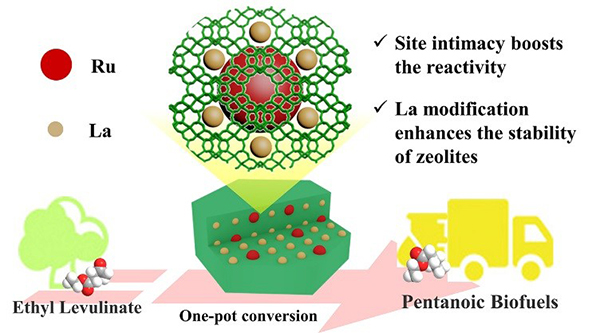Scientists Discover Zeolite-tailored Active Site Proximity for the Efficient Production of Pentanoic Biofuels
Non-edible biomass, a prime, renewable and abundant carbon-based alternative, can serve as a viable substitute for the sustainable production of fuels, chemicals and materials.
Pentanoic esters, produced from lignocellulose-derived levulinic acid (LA), have been identified as promising biofuels due to its high energy density and superior compatibility with traditional gasoline.
Recently, Dr. LUO Wenhao and Prof. ZHANG Tao's group from the Dalian Institute of Chemical Physics (DICP) of the Chinese Academy of Sciences (CAS), in collaboration with Professor Bert M. Weckhuysen from Utrecht University, designed a new strategy for efficient production of pentanoic biofuels.
The researchers synthesized well-dispersed and ultra-small Ru metal nanoclusters, confined within the micropores of zeolite Y, which provided the required active site intimacy and boosted the chemoselectivity towards the production of pentanoic biofuels in the direct, one-pot hydrodeoxygenation (HDO) of neat ethyl levulinate.
This study was published in Angewandte Chemie International Edition on August 19th.

Zeolite-tailored active site proximity boosts the catalytic activity and selectivity for the direct hydrodeoxygenation of neat ethyl levulinate into pentanoic biofuels (Image by HE Jiang)
Instead of usually starting molecule LA, the researchers proposed a novel strategy for the direct production of pentanoic biofuels starting from neat ethyl levulinate (EL), using zeolite-supported bifunctional catalysts with confined active site proximity. They revealed that confined proximity significantly promoted the catalytic activity and selectivity to the production of pentanoic biofuels in the direct hydrodeoxygenation of neat EL.
In addition, They found that La modification was an efficient approach to retain the catalyst performance, owing to stabilizing the zeolite framework against deconstruction during thermocatalysis in the liquid phase.
Those findings extended the notion of "the closer, the better" into biomass catalysis. Such confined proximity in the zeolite cavities enabled efficiently coupling of catalytic reactions in a direct, one-pot process, which created opportunities for the practical production of pentanoic biofuels.
The above work was supported by National Key R&D Program of China, National Natural Science Foundation of China, and the Foundation of Dalian Institute of Chemical Physics. (Text by HE Jiang)